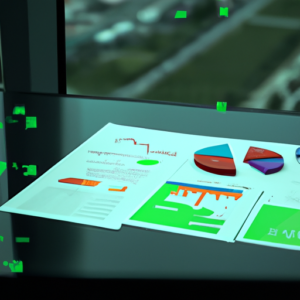CRM and ERP: An Essential guide
Learning About CRM and ERP: A Comprehensive Guide
Table Of Contents
- Introduction
- Understanding CRM
- What is CRM and how does it work?
- Different types of CRM systems
- Examples of popular CRM services, including Microsoft Dynamics 365 and Odoo CRM
- Benefits of using CRM for your business
- Understanding ERP
- What is ERP and how does it work?
- Different types of ERP systems
- Examples of popular ERP services, including Microsoft Dynamics 365 and Odoo ERP
- Benefits of using ERP for your business
- Differences between CRM and ERP
- Key differences between CRM and ERP systems
- How they complement each other in a business setting
- Implementing CRM and ERP
- Choosing the right CRM and ERP system for your business
- Best practices for implementing CRM and ERP systems
- Challenges to consider during implementation
- Case studies of successful CRM and ERP implementations
- Conclusion
- The importance of CRM and ERP for modern businesses
- Future developments and trends in CRM and ERP
- Final thoughts and recommendations
Introduction
 CRM (Customer Relationship Management) and ERP (Enterprise Resource Planning) are two critical business software solutions that organizations utilize to manage various aspects of their operations. While they are two separate systems, they are often integrated to provide organizations with a more comprehensive view of their business processes. In this guide, we will discuss the basics of CRM and ERP, their benefits, and how Microsoft Dynamics 365 and Odoo CRM are two examples of these systems.
CRM (Customer Relationship Management) and ERP (Enterprise Resource Planning) are two critical business software solutions that organizations utilize to manage various aspects of their operations. While they are two separate systems, they are often integrated to provide organizations with a more comprehensive view of their business processes. In this guide, we will discuss the basics of CRM and ERP, their benefits, and how Microsoft Dynamics 365 and Odoo CRM are two examples of these systems.
What is CRM?
CRM software is designed to manage customer interactions and provide insights into customer behavior. It is a system that enables organizations to manage their customer relationships, including customer interactions, sales, marketing, and customer service. CRM systems capture customer data, such as contact information, purchasing history, and social media activity, to provide organizations with insights into customer behavior and preferences.
One example of a CRM system is Microsoft Dynamics 365. This system provides organizations with a complete view of their customers’ interactions, helping them understand their customers’ needs and preferences. Microsoft Dynamics 365 offers various features, including sales automation, marketing automation, customer service management, and business analytics. With these features, organizations can automate their sales processes, streamline marketing campaigns, manage customer inquiries, and analyze customer data to gain insights into customer behavior.
What is ERP?
ERP software is designed to manage various business processes, including finance, human resources, supply chain management, inventory, and procurement. ERP systems integrate these different aspects of business operations into a single system, providing organizations with a unified view of their business processes. ERP systems capture data from various business processes and provide insights into these processes, helping organizations make informed decisions.
Odoo CRM is an example of an ERP system that also includes a CRM module. This system offers a range of features, including sales management, project management, accounting, inventory management, and human resources management. With its CRM module, Odoo CRM enables organizations to manage their customer interactions and gain insights into customer behavior. Additionally, with its other features, Odoo CRM enables organizations to streamline their operations and improve their overall business processes.
Benefits of CRM and ERP
CRM and ERP systems offer numerous benefits to organizations. By providing a unified view of business processes, these systems enable organizations to streamline their operations and improve their overall efficiency. By capturing and analyzing data, these systems provide organizations with insights into their business processes, helping them make informed decisions. Additionally, by automating certain processes, these systems enable organizations to reduce the time and resources required to manage their operations.
Microsoft Dynamics 365 and Odoo CRM are two examples of CRM and ERP systems that provide numerous benefits to organizations. With their features and capabilities, these systems enable organizations to manage their operations effectively and efficiently. Microsoft Dynamics 365 provides organizations with a complete view of their customers’ interactions, enabling them to understand their customers’ needs and preferences. Odoo CRM provides organizations with a range of features that enable them to manage their operations effectively, including sales management, project management, accounting, and human resources management.
Understanding CRM
 CRM (Customer Relationship Management) systems are software tools designed to help organizations manage their customer relationships, from marketing to sales to customer service. There are various types of CRM systems available, each with its own unique features and functionalities. The three main types of CRM systems are operational, analytical, and collaborative. Operational CRM systems are designed to streamline business processes, such as sales and marketing automation. Analytical CRM systems focus on analyzing customer data to gain insights and inform decision-making. Collaborative CRM systems facilitate communication and collaboration between different teams within an organization.
CRM (Customer Relationship Management) systems are software tools designed to help organizations manage their customer relationships, from marketing to sales to customer service. There are various types of CRM systems available, each with its own unique features and functionalities. The three main types of CRM systems are operational, analytical, and collaborative. Operational CRM systems are designed to streamline business processes, such as sales and marketing automation. Analytical CRM systems focus on analyzing customer data to gain insights and inform decision-making. Collaborative CRM systems facilitate communication and collaboration between different teams within an organization.
Implementing a CRM system can provide many benefits to an organization, including improved customer satisfaction, increased sales, and enhanced efficiency. CRM systems can help organizations better understand their customers by capturing and analyzing customer data. This data can then be used to create personalized marketing campaigns and improve the overall customer experience. Additionally, CRM systems can automate tedious tasks such as data entry and lead tracking, freeing up employees’ time to focus on higher-level tasks.
There are many different CRM systems available on the market, each with its own unique set of features and functionalities. Two examples of popular CRM systems are Microsoft Dynamics 365 and Odoo CRM. Microsoft Dynamics 365 is a cloud-based CRM system that offers a range of features, including sales automation, customer service management, and marketing automation. The system can also be customized to fit the specific needs of an organization. Odoo CRM is another popular CRM system that offers a range of features, including lead management, pipeline management, and customer segmentation. Odoo CRM is open-source, which means it can be customized and modified by users to fit their specific needs. Both Microsoft Dynamics 365 and Odoo CRM are widely used by organizations of all sizes to manage their customer relationships and improve their overall business operations.
You can read more on Dynamics 365 and Odoo CRM here:
Microsoft 365 Dynamics: A brief Introduction
Understanding ERP
Types of ERP systems can be broadly categorized into on-premise, cloud-based, and hybrid systems. On-premise ERP systems are installed locally on a company’s own hardware and infrastructure, while cloud-based ERP systems are hosted on remote servers and accessed through the internet. Hybrid systems are a combination of on-premise and cloud-based systems. Each type of ERP system has its own advantages and disadvantages, and companies should carefully consider their needs and budget before deciding which type to implement.
The benefits of ERP systems are numerous, including increased efficiency, better collaboration and communication across departments, improved data accuracy and accessibility, and enhanced decision-making capabilities. By consolidating data and automating processes, ERP systems can help businesses streamline their operations and reduce costs. ERP systems can also help businesses better manage their inventory, production schedules, and customer relationships, leading to improved customer satisfaction and retention.
Two examples of popular ERP systems are SAP and Oracle. SAP is a market leader in ERP software, with a range of products designed to meet the needs of businesses of all sizes. SAP’s ERP solutions offer a range of features, including financial management, inventory management, and procurement. Oracle is another popular ERP system, known for its robust financial management capabilities. Oracle’s ERP software includes modules for financials, procurement, supply chain management, and project management. Both SAP and Oracle offer cloud-based ERP solutions, making it easier for businesses to implement and manage their ERP systems.
Differences between CRM and ERP
While both CRM and ERP systems offer benefits to businesses, they are distinct in their focus and functionality. CRM systems are primarily focused on managing and analyzing customer interactions and data, such as sales, marketing, and customer service. ERP systems, on the other hand, are designed to manage and automate business processes related to finance, human resources, and supply chain management. While some ERP systems may offer CRM functionality as well, their primary focus is on managing internal business processes rather than customer interactions.
Implementing CRM and ERP
Choosing the Right CRM and ERP System for your Business
 Choosing the right CRM and ERP system for your business can be a daunting task, but there are several factors to consider that can help guide your decision. One factor is the size of your business and the complexity of your business processes. Small businesses with simpler processes may benefit from a simpler CRM or ERP system, while larger businesses with more complex processes may require a more robust and customizable system. Other factors to consider include cost, integration with other business systems, and ease of use. It is important to carefully evaluate your options and choose a system that meets your business needs both now and in the future.
Choosing the right CRM and ERP system for your business can be a daunting task, but there are several factors to consider that can help guide your decision. One factor is the size of your business and the complexity of your business processes. Small businesses with simpler processes may benefit from a simpler CRM or ERP system, while larger businesses with more complex processes may require a more robust and customizable system. Other factors to consider include cost, integration with other business systems, and ease of use. It is important to carefully evaluate your options and choose a system that meets your business needs both now and in the future.
Best practices for implementing CRM and ERP systems:
Implementing a CRM or ERP system requires careful planning and execution to ensure its success. It is important to start with a clear understanding of your organization’s needs and goals. This will help you choose the right system and tailor it to your specific requirements. It is also important to involve all relevant stakeholders in the planning process to ensure their buy-in and support.
Another best practice is to start with a pilot project before rolling out the system to the entire organization. This will help you identify any potential issues and make any necessary adjustments before the system goes live. It is also important to provide comprehensive training and support to end-users to ensure they are comfortable with the new system and can use it effectively.
Challenges to consider during implementation:
While implementing a CRM or ERP system can bring many benefits to an organization, there are also several challenges to consider. One of the biggest challenges is resistance to change from end-users. This can be addressed through effective change management strategies, such as involving end-users in the planning process and providing comprehensive training and support.
Another challenge is data migration. This involves transferring data from legacy systems to the new CRM or ERP system. It is important to ensure that the data is accurate and complete to avoid any issues with the new system. This can be a time-consuming and complex process, but it is essential for the success of the new system.
Case studies of successful CRM and ERP implementations:
There are many examples of organizations that have successfully implemented CRM and ERP systems. One such example is Microsoft Dynamics 365. This cloud-based system provides a range of features, including sales and marketing automation, customer service management, and project management. One organization that successfully implemented Microsoft Dynamics 365 is Yaskawa America, a manufacturer of industrial robots. By implementing this system, Yaskawa America was able to improve its customer service and streamline its sales and marketing processes.
Another example of a successful CRM and ERP implementation is Odoo CRM. This open-source system provides a range of features, including lead management, sales pipeline management, and customer service management. One organization that successfully implemented Odoo CRM is MHI, a company that provides industrial equipment and systems. By implementing this system, MHI was able to streamline its sales processes and improve its customer service.
Conclusion
CRM and ERP systems are critical business software solutions that enable organizations to manage their operations effectively and efficiently. By capturing and analyzing data, these systems provide organizations with insights into their business processes, helping them make informed decisions. Microsoft Dynamics 365 and Odoo CRM are two examples of these systems that provide numerous benefits to organizations. By utilizing these systems, organizations can streamline their operations, reduce costs, and improve their overall efficiency. As organizations continue to embrace technology, CRM and ERP systems will become increasingly essential for managing business operations.









